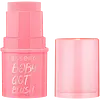What's inside
What's inside
 Key Ingredients
Key Ingredients

 Benefits
Benefits

 Concerns
Concerns

 Ingredients Side-by-side
Ingredients Side-by-side

Octyldodecanol
EmollientC12-15 Alkyl Benzoate
AntimicrobialSilica
AbrasiveSynthetic Wax
AbrasiveDimethicone
EmollientCetearyl Ethylhexanoate
EmollientMica
Cosmetic ColorantPolyglyceryl-2 Triisostearate
EmulsifyingEuphorbia Cerifera Wax
Caprylic/Capric Triglyceride
MaskingSilica Silylate
EmollientMethicone
EmollientPhenoxyethanol
PreservativeStearalkonium Hectorite
Gel FormingAluminum Hydroxide
EmollientLimnanthes Alba Seed Oil
Skin ConditioningMangifera Indica Seed Butter
Skin ConditioningSimmondsia Chinensis Seed Oil
EmollientTocopheryl Acetate
AntioxidantPropylene Carbonate
SolventCI 77891
Cosmetic ColorantCI 77491
Cosmetic ColorantCI 77492
Cosmetic ColorantCI 77499
Cosmetic ColorantOctyldodecanol, C12-15 Alkyl Benzoate, Silica, Synthetic Wax, Dimethicone, Cetearyl Ethylhexanoate, Mica, Polyglyceryl-2 Triisostearate, Euphorbia Cerifera Wax, Caprylic/Capric Triglyceride, Silica Silylate, Methicone, Phenoxyethanol, Stearalkonium Hectorite, Aluminum Hydroxide, Limnanthes Alba Seed Oil, Mangifera Indica Seed Butter, Simmondsia Chinensis Seed Oil, Tocopheryl Acetate, Propylene Carbonate, CI 77891, CI 77491, CI 77492, CI 77499
Ricinus Communis Seed Oil
MaskingOctyldodecanol
EmollientNeopentyl Glycol Dicaprylate/Dicaprate
EmollientCI 77220
Cosmetic ColorantIsostearyl Alcohol
EmollientKaolin
AbrasiveOryza Sativa Bran Wax
Skin ConditioningEuphorbia Cerifera Wax
Cocos Nucifera Oil
MaskingDisteardimonium Hectorite
StabilisingTocopheryl Acetate
AntioxidantGlyceryl Caprylate
EmollientPentaerythrityl Tetra-Di-T-Butyl Hydroxyhydrocinnamate
AntioxidantAluminum Hydroxide
EmollientParfum
MaskingCI 15850
Cosmetic ColorantCI 77491
Cosmetic ColorantCI 77492
Cosmetic ColorantCI 77891
Cosmetic ColorantRicinus Communis Seed Oil, Octyldodecanol, Neopentyl Glycol Dicaprylate/Dicaprate, CI 77220, Isostearyl Alcohol, Kaolin, Oryza Sativa Bran Wax, Euphorbia Cerifera Wax, Cocos Nucifera Oil, Disteardimonium Hectorite, Tocopheryl Acetate, Glyceryl Caprylate, Pentaerythrityl Tetra-Di-T-Butyl Hydroxyhydrocinnamate, Aluminum Hydroxide, Parfum, CI 15850, CI 77491, CI 77492, CI 77891
 Reviews
Reviews

Ingredients Explained
These ingredients are found in both products.
Ingredients higher up in an ingredient list are typically present in a larger amount.
Aluminum Hydroxide is a form of aluminum. It can be naturally found in nature as the mineral gibbsite. In cosmetics, Aluminum Hydroxide is used as a colorant, pH adjuster, and absorbent.
As a colorant, Aluminum Hydroxide may add opacity, or reduce the transparency. Aluminum hydroxide is contains both basic and acidic properties.
According to manufacturers, this ingredient is an emollient and humectant. This means it helps hydrate the skin.
In medicine, this ingredient is used to help relieve heartburn and help heal ulcers.
There is currently no credible scientific evidence linking aluminum hydroxide in cosmetics to increased cancer risk.
Major health organizations allow the use of aluminum hydroxide in personal care products and have not flagged it as a carcinogenic risk at typical usage levels.
Learn more about Aluminum HydroxideCi 77491 is also hydrated iron III oxide. It's sole purpose is to give a red/pink hue to products.
Iron III oxides are classified as inorganic chemicals for coloring.
Synthetically created Ci 77491 is considered safer than those naturally found. This is because the synthetically created version may contain less impurities. Iron oxides are generally non-toxic and non-allergenic.
Learn more about CI 77491Ci 77492 is also hydrated iron III oxide. It's sole purpose is to give a yellow hue to products.
Iron III oxides are classified as inorganic chemicals for coloring.
Synthetically created Ci 77492 is considered safer than those naturally found. This is because the synthetically created version may contain less impurities. Iron oxides are generally non-toxic and non-allergenic.
Learn more about CI 77492Ci 77891 is a white pigment from Titanium dioxide. It is naturally found in minerals such as rutile and ilmenite.
It's main function is to add a white color to cosmetics. It can also be mixed with other colors to create different shades.
Ci 77891 is commonly found in sunscreens due to its ability to block UV rays.
Learn more about CI 77891Octyldodecanol is a fatty alcohol. It is primarily used to enhance the texture of products.
As an emulsifier, Octyldodecanol helps prevent the oils and waters from separating. It also prevents ingredients from creating foam when shaken.
Octyldodecanol is created by reducing fatty acid to an alcohol.
Due to its high molecular weight, it does not get absorbed into the skin.
Learn more about OctyldodecanolTocopheryl Acetate is AKA Vitamin E. It is an antioxidant and protects your skin from free radicals. Free radicals damage the skin by breaking down collagen.
One study found using Tocopheryl Acetate with Vitamin C decreased the number of sunburned cells.
Tocopheryl Acetate is commonly found in both skincare and dietary supplements.
Learn more about Tocopheryl AcetateEuphorbia Cerifera wax comes from a shrub in Northern Mexico. It is used to stabilize formulations and has emollient properties.
Emollients form a thin layer on top of skin to prevent water from evaporating, keeping skin and lips hydrated.
According to a manufacturer, this wax can range from a yellow/brown color to translucent.
Learn more about Euphorbia Cerifera Wax